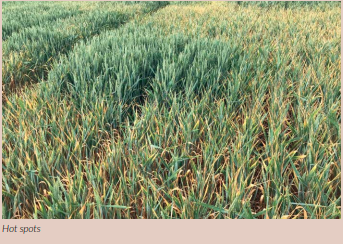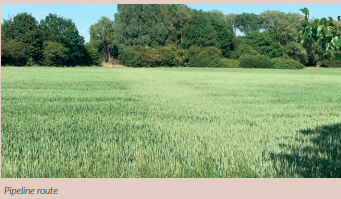
Thoughts and lessons learned from the season. Where to start???
Well the earth on the farm went from very wet over winter to very dry. April was the sunniest it’s been since 1929 I believe, with the drought being broken towards the end of the month by some very welcome rain. We have been treated to the clearest air and the bluest skies that anyone has seen for many decades. It’s a shame that it’s taken a global pandemic and shutdown of industrial operations and carefree travel to make the change to the environment that we have been aware is needed for a while now.
May continued dry and we start to think that we need some vapour trails and upper air pollution to create conditions for rain to happen again! Whilst we do all we can to improve soil heath and structure and increase SOM to improve drought resistance still on light land the effect of insufficient precipitation combined with high temperatures and high winds have drained yield potential. So thoughts turn to combating drought and coincidentally on the internet popped up an article The Drought Myth, An Absence of Water is Not the Problem by William Albrecht.
www.appropedia.org/Drought_Myth
which discusses the role of nutrition in combating drought. I have been adding trace elements to spray applications at every opportunity but have still found that the absence of water is a big problem. More work needed here. Even the more specialist bio extracts appears to have made no difference. Soil structure and subsoil is no doubt very important and I’m always reminded of this by the route of a pipeline which crossed a field well over twenty years ago. The crop is always stunted and looks hungry (see pic) but the same soil was replaced in the trench that was removed, just in a different order.

On the worst field I have for “hot spots” (see pic) the difference in crop changes dramatically in just a few inches. You would not think it was possible as we expect roots to roam for moisture and nutrition on top of their increased efficiency through association with Arbuscular Mycorrhiza Fungi. I will taking soil samples from 0-300mm and 300-600 analysed to see what differences can be found.

On top of how we physically farm the soil we are trying to reduce crop inputs, jump off the treadmill of nannying crops with insurance PPPs and let crops on our healthier soils with an increased number of beneficials stand up for themselves.
I have had success with this approach again this year with insecticide free crops of wheat and rape but less success with reducing fungicides. Learning where we can successfully cut back is still a work in progress. I refuse to be persuaded to apply a T0 to wheat preferring it to stand on its own feet but it’s surprising how quickly patches of yellow rust started to appear on my varieties of GP1 wheats. These being Zyatt, Solstice or Skyfall or a blend of the three. A T1 needed to be applied very swiftly, and to keep on top of the problem a well timed T2. Nothing saved there then!
Autumn insecticides are avoided when ever possible but we do need to be aware of the risks from the green bridge between crops, and on one field of wheat the aphid population that inhabited the volunteer oats and possibly were living in the excessive amount of wet chopped straw has infected the wheat fairly badly despite a poorly timed (with hindsight) insecticide application. As part of our IPM we really need to be able to get aphids tested to see what disease they are carrying and have regional data on this.
Spring seedbeds were a challenge following the excessive amount of winter rainfall but as a rule better (dryer) where the cover crops had been left growing until early February than sprayed off before Christmas, in this case to get a second flush of Blackgrass. The ground does need to be dry enough to crumble into the slot or at least not mush back together again after the seed is placed and in the early sprayed off field it was not. With hindsight again I should have moved this a couple of inches deep to let it dry but had no machine for the job other than going over it with the Horsch tine drill. To that end I’ve found and purchased a super cheap new 3mt disc and packer machine which I’m fitting a seeder box to. This will perform three tasks, 1. covercrop establishment, 2. light movement of any seedbed to dry it if necessary and 3. mechanical covercrop destruction to reduce reliance of, or number of lts/ha required, in producing a clean environment to drill into of glyphosate. This is something I trialed in late autumn 2018 with a very lovely but expensive Lemken Rubin machine with some success.

Headlands. I’m surely not the only one that has headlands that look better than the field! I haven’t quite worked out why this is but on a traditional cultivation system headlands were always the poor relation, especially in a wet year.
Thoughts around this are, better consolidation, in a no-till system is this possible? Fewer slugs due to consolidation. An effect of some type from the surrounding flora. Extra nitrogen due to me not cutting back the rate enough on the headland setting, but half of the N is applied as liquid! Drilling more slowly, or something else. Thoughts appreciated via Twitter or Farming Forum/BASE UK forum if you can please.
So to sum up. The farm doesn’t look too bad and with a well timed rain and a little less heat and wind in May it would have looked very good. I can’t blame the no-till system, now it it’s fifth year here, for any crops that look less than perfect other than some spring barley and that was down to poor judgement on the day by me. The better well bodied land has the better crops due to holding more moisture than the land with sand under it. The ability to chose either the disc or tine drill depending on circumstances has been invaluable with the JD750a doing a fabulous job in green catch crops and the Horsch Dutch conversion likewise into wet chopped straw on wheat after oats or second wheats. In fact the no-till system afforded me the ability to drill 130% of planned wheat area in what was one of the most difficult autumns we can remember.
Finally the desire to farm using many fewer artificial inputs is very laudable but there are risks when we back to rein back too far.
What is holding us back at the moment is the risk/reward balance, something organic farmers have much better sorted and to help progress Regenerative Agriculture more quickly premiums that support the way that we are farming would be helpful.